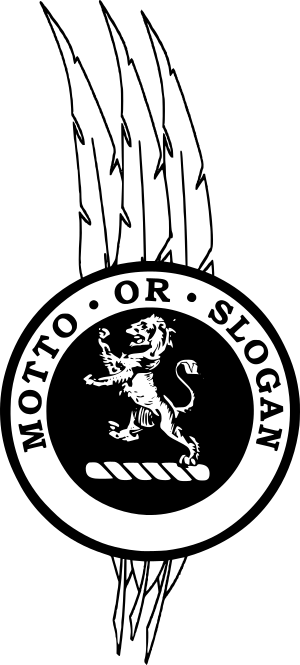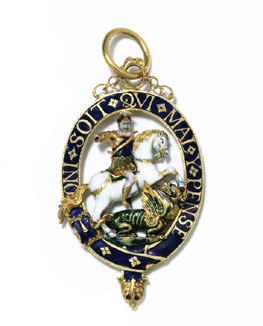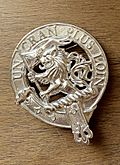Scottish crest badge facts for kids

A Scottish crest badge is a special symbol worn to show you belong to a certain Scottish family or clan. People often call them "clan crests," but this isn't quite right. There's no such thing as a crest that belongs to a whole clan. Instead, the crest and motto belong to the clan chief.
These badges have two main parts: a heraldic crest (a symbol from a coat of arms) and a motto or saying. These symbols are very important and are protected by law in Scotland. Anyone can wear a crest badge. But if you don't legally own the crest and motto, your badge will have a strap and buckle around it. This shows you are a follower of the person who owns that crest and motto. If you do own the symbols (meaning you have your own coat of arms), your badge might have a plain circle instead of the strap and buckle.
Scottish clan members often wear these badges. They usually feature parts of their clan chief's coat of arms. When clan members wear their chief's crest and motto with a strap and buckle, it shows they are part of that chief's clan or family. Some clans don't have a chief officially recognized by the Lord Lyon King of Arms. In these cases, clan members might wear the badge of the last known chief. Even though you can buy "clan crests," remember that the crest and motto truly belong only to the chief, not to individual clan members.
Crest badges, like clan tartans, are not very old. They became popular in the 1800s during the Victorian era, a time when people loved romantic ideas about history. Before that, clans used to wear specific plants in their hats or on poles as their badges.
Contents
What is a Scottish Crest Badge?

Even though many people say "clan crest," it's not the correct term. There isn't a crest that belongs to an entire clan. You can buy crest badges, and you can own the badge itself. However, the actual crest symbol and the motto on the badge belong only to the clan chief. They are the chief's personal property. Clan members are allowed to wear the badge to show loyalty to their clan and chief. It's against the law for a clan member to use the chief's crest and motto for other things, like on silverware or rings. Simply put, coats of arms, crests, and mottos are owned by one person. For "clan crests," they belong to the clan chief.
Crest badges are made for people to wear. They are usually made of silver or a similar white metal. When shown in pictures, crest badges should only be in black and white, never in color. Women can wear a crest badge as a brooch, usually on their left side. For this, the badge might even be made of gold.
Some clans don't have a chief recognized by the Lord Lyon King of Arms. In these cases, clan members usually wear a crest badge with the crest and motto of the last known chief.
Who Can Wear a Crest Badge?
You don't have to be part of a clan society to wear a crest badge. Any clan member can wear one. The Court of the Lord Lyon says that clan membership often goes with your last name. However, some people whose last name isn't a clan name might wear their mother's clan badge. Also, anyone who promises loyalty to a clan chief is considered a member of that clan.
Many people have names that are not main clan surnames but are "sept names" or names linked to certain clans. Names like Smith, Wright, Fletcher, and Miller are examples. This is because every clan would have had its own smiths, builders, arrow makers, and millers. It's up to each person to look into their family history to find out which clan they belong to.
Parts of a Crest Badge
Scottish crest badges can have these parts:
| Crest | A crest is a symbol that sits above the shield on a coat of arms. You can't own a crest without also having a coat of arms. In Scottish heraldry, the crest usually comes with a motto or slogan. Sometimes, an extra motto is given, which might also appear on a clan member's crest badge. | |
| Wreath | The wreath is seen on a coat of arms between the crest and the helmet. On a crest badge, the wreath is always placed below the crest. This shows that it is a proper heraldic crest. | |
| Coronet | A coronet or an antique crown can sometimes take the place of the wreath in some crests. The antique crown (pictured top) has five points that you can see. The coronet (pictured bottom), also called a "crest coronet," has three visible strawberry leaves. | |
| Chapeau | The heraldic chapeau is a special hat that can replace the wreath in some crests. It can also appear between the wreath and the crest. The chapeau shows that the owner has a certain high rank, like a baron. |
How to Wear a Crest Badge
Clan chiefs, clan chieftains, clan members who own their own coat of arms, and clan members who don't own a coat of arms can all wear crest badges. However, the type of badge they wear is different.
Clan Chiefs
A clan chief is the leader of their clan or family. They represent the family's original founder. A clan chief must be recognized by the Lord Lyon King of Arms. They must also have the original, unchanged undifferenced arms of their family name.
Clan chiefs can wear their crest simply, without a circle or feathers. But it's more common for a chief to wear their own crest inside a plain circle with their motto or slogan (pictured left). The chief's crest badge does not have the strap and buckle that other clan members wear. Clan chiefs can also wear three eagle feathers behind the circle of their crest badge. For special events, like clan gatherings, they might use real eagle feathers. If a clan chief is a member of the British Peerage (a noble title) or a feudal baron, they can wear the right coronet or special hat above the circle on their badge. This is their personal choice.
Clan Chieftains
Clan chieftains are leaders of large parts of a Scottish clan. They are officially recognized as clan chieftains by the Lord Lyon King of Arms.
Clan chieftains, like chiefs, can wear their own crest inside a plain circle with their own motto or slogan. Clan chieftains can also wear two small eagle feathers. This is different from the chief's three feathers. Sometimes, real eagle feathers can be worn behind the crest badge. If a clan chieftain is a member of the British Peerage or a feudal baron, they can wear the right coronet or special hat above the circle on their crest badge. Clan chieftains can also wear their chief's crest badge, just like other clan members who don't own their own coat of arms.
Clan Members with Their Own Coat of Arms
In Scottish Heraldry, a person with their own coat of arms is called an "armiger." This means they have officially registered their own coat of arms. Or, they have inherited a coat of arms from an ancestor who had their arms recorded in Scotland.
Armigers, like clan chiefs and chieftains, can wear their own crest inside a plain circle with their own motto or slogan. Armigers are allowed to wear one silver eagle feather behind the circle. Sometimes, they might wear a real eagle feather for special events. If an armiger is a member of the British Peerage or a feudal baron, they can wear the right coronet or special hat above the circle on their crest badge. If an armiger is also a member of a Scottish clan, they can wear their chief's crest badge. However, it must be surrounded by a strap and buckle.
Clan Members Without Their Own Coat of Arms

Members of Scottish clans are seen by the Court of the Lord Lyon as relatives of their clan chief. They can be close family or extended family. Clan members can also be people who just have the "clan surname" or a sept name linked to the clan. The Court of the Lord Lyon has also said that anyone who promises loyalty to both the clan and its chief can be a clan member. All clan members can wear the chief's crest surrounded by a strap and buckle. The strap and buckle will have their chief's motto or slogan written on it. This strap and buckle shows that you are a member of the clan and loyal to the clan chief.
See also
- Scottish heraldry
- List of Scottish clans
- Clan badge, said to be the earlier of badges used by members of Scottish clans
- Heraldic badge, an English version of the crest badge







